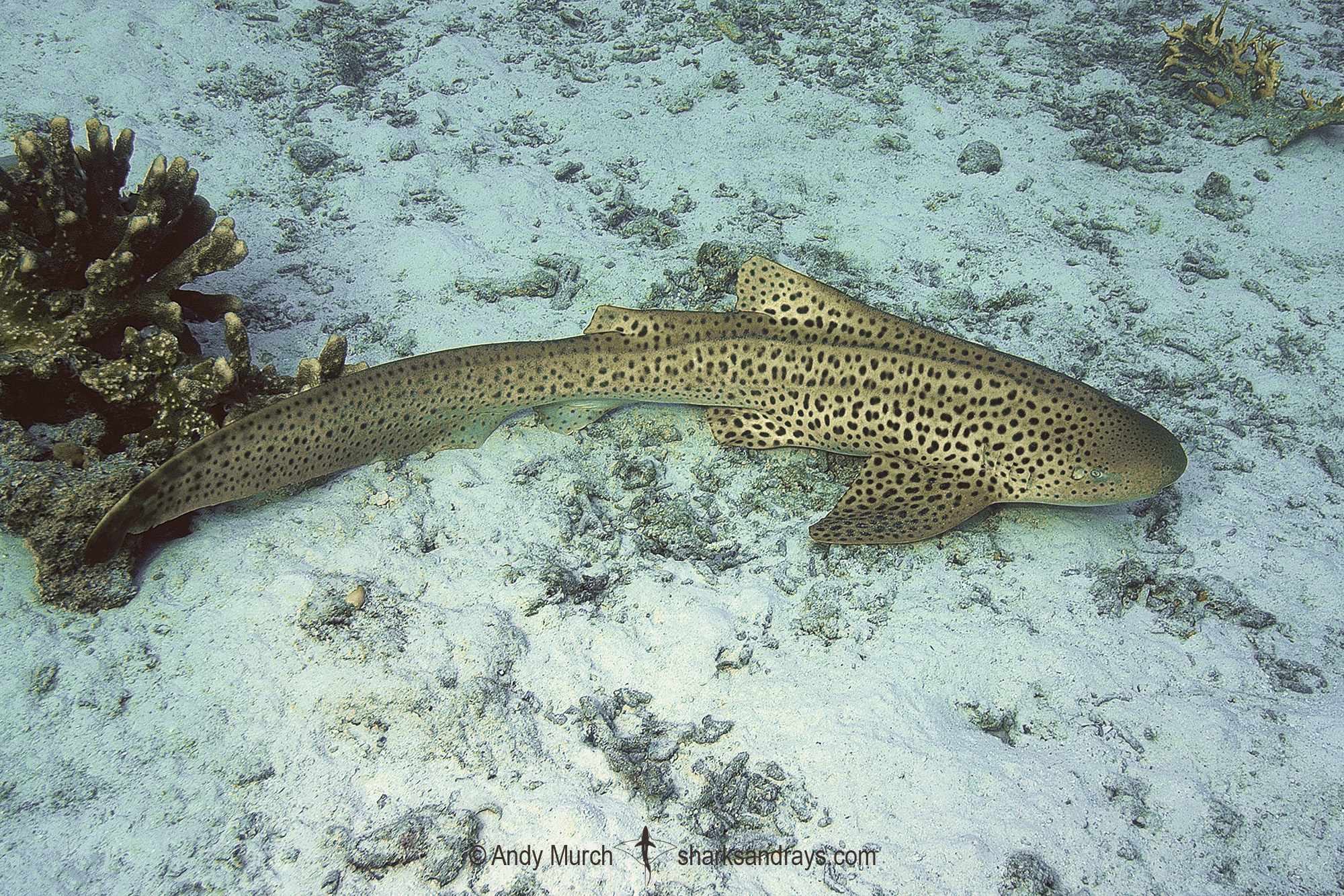Common name(s)
Zebra Shark, Leopard Shark.
Identification
A large species of shark with a rounded snout shorter than mouth width. First and second dorsal fins long and low; length 2-3 x height. Free rear tip of first dorsal overlaps second dorsal origin. First dorsal origin posterior to free rear tip of pectoral fin. Pectoral fins large with rounded tips. Caudal fin extremely long; almost half total length.
Dorsal coloration olive, yellow, or beige with many small black spots. Ventrum pale. Juveniles have black or brown vertical (zebra-like) stripes on a cream or yellow background. Stripes eventually break up into spots.
Size
Maximum verified length 246cm. Size at birth approximately 20-36cm.
Habitat
Warm-temperate and tropical seas. Found on sand around coral reefs and slopes adjacent to reefs. Intertidal to at least 62m. Paucity of sightings of striped young indicates that they inhabit deeper water and likely secretive.
Distribution
The zebra shark is found throughout the Indian Ocean, Red Sea, Persian Gulf, and the western Pacific.
Conservation Status
ENDANGERED
The Zebra Shark (Stegostoma tigrinum) is usually found within a narrow band of shallow coral reef habitat and soft bottom that is heavily fished throughout all of its range except Australia. It is taken in inshore fisheries (demersal trawls, floating and fixed bottom gillnets and baited hooks) and regularly seen in fish markets in Indonesia, Thailand, Philippines, Pakistan, India, Taiwan, and elsewhere. There are limited data on population declines in these areas, with the exception of the Gulf of Thailand, but the species is susceptible to capture in a wide range of fisheries, has a narrow habitat range with potential limited dispersal, shows strong site fidelity and forms aggregations which facilitate the rapid removal of individuals.
Population genetic analysis supports two subpopulations of the Zebra Shark: Indian Ocean-Southeast Asian and Eastern Indonesian-Oceania. The greatest levels of exploitation and ongoing threats for this species occurs in Southeast Asia, particularly Thailand through to Indonesia. Given little or no genetic exchange from unexploited areas it is suspected that this subpopulation has declined by at least 50% over the last three generations (51 years) and these threats are suspected to continue at these levels into the future. Therefore the Indian Ocean-Southeast Asian subpopulation is considered Endangered. The Eastern Indonesian-Oceania subpopulation is composed of regions with minimal exploitation to this species as well as regions of greater fishing pressure and habitat threats. In particular, the Zebra Shark in Australian waters is considered Least Concern due to minimal impacts from fishing, non-consumptive exploitation and habitat loss. However, population genetic and tracking studies suggest there is likely to be exchange between Australian waters and the Arafura Sea in Eastern Indonesian waters where extensive trawl fishing occurs and has been increasing in intensity over the last 30 years. Based on the ongoing fishing and habitat threats posed by these trawl fisheries in the Arafura Sea and the potential impacts on Zebra Sharks migrating from adjacent regions, reductions of at least 20% of its population size within three generations (51 years) are suspected and the Eastern Indonesian-Oceania subpopulation is assessed as Near Threatened.
By combining the subpopulation assessments according to relative area (the Indian Ocean-Southeast Asian subpopulation has approximately 70% of the available habitat; the Eastern Indonesian-Oceania subpopulation has approximately 30% of the available coastal habitat), and given the ongoing threats from fishing and habitat loss across much of its range and suspected reductions of over 50% of its population size within three generations, this species is assessed globally as Endangered.
Citations and References
Dudgeon, C.L., Simpfendorfer, C. & Pillans, R.D. 2019. Stegostoma fasciatum (amended version of 2016 assessment). The IUCN Red List of Threatened Species 2019: e.T41878A161303882. https://dx.doi.org/10.2305/IUCN.UK.2019-3.RLTS.T41878A161303882.en. Downloaded on 07 January 2021.
Reproduction
Oviparous. Captive animals have laid 40-80 egg cases per year. However, only 25% of egg cases successfully hatched.
Diet
The zebra shark mostly feeds on mollusks and crustaceans, plus bony fishes and possibly sea snakes.
Behavior
Often seen resting on the sand next to reefs. Usually solitary but sometimes forms aggregations (e.g. in Byron Bay, Australia). Wriggles into tight openings on the reef in search of prey.
Zebra sharks undergo extensive annual migrations of up to 2000km along the coast of Australia.
Reaction to divers
Quite easy to approach. Remains at rest unless closely harassed.
Diving logistics
While diving at the Similan Islands in Thailand in the 1990’s, I encountered zebra sharks on virtually every dive. Over the last two decades, their numbers have slowly decreased to the point where they are seldom seen in Thailand anymore.
Fortunately, zebra sharks are still abundant along the coast of Australia. They can be seen almost anywhere in Queensland and far northern NSW, but the best area seems to be from Gladstone to Coffs Harbour, with virtually guaranteed sightings during the summer at Rainbow Beach, Brisbane, Tweed Heads, and Byron Bay.
Zebra sharks are also seen by divers (in less numbers) off the east coast of Africa, from Egypt all the way down to Sodwana Bay in South Africa.
What’s new
View our full list of updates
Similar species
No other sharks closely resemble the zebra shark.




